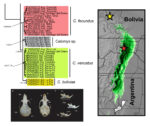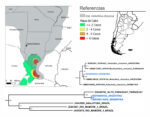Molecular data suggest that Calomys boliviae (Thomas, 1901) would be a valid species belonging to the western lineage of the Calomys callosus complex (Rodentia, Cricetidae)
María Laura Martin, Susana Revollo-Cadima, Renata Salas, Edgar Quispe, Germán O'Duyer, José Paura, César Polidoro, Enzo A. Rossi, Raúl E. González-IttigThe Calomys callosus complex involves species with medium to large body sizes for the genus and so far includes C. callosus sensu stricto, C. fecundus, C. callidus, C. venustus, C. tocantinsi, and Calomys sp., the latter representing populations from the Beni savannah of Bolivia. There is also a species named C. boliviae from the Yungas ecoregion of central Bolivia, which has often been synonymized with C. fecundus, a species found in the Tucumane-Bolivian Yungas ecoregion of northern Argentina and southern Bolivia. In the present study, we report the molecular analysis, based on the mitochondrial Cyt-b gene, of specimens of Calomys sampled in the Bolivian Yungas in an area close to the type locality of C. boliviae. Phylogenetic results showed that the sequences of the specimens studied formed a clade distinct from C. fecundus and that, taking into account its geographical closeness to the typical area of C. boliviae, they could be representing this nominal form. If this hypothesis is true, C. boliviae should be resurrected as a valid species of Calomys belonging to the western lineage within the C. callosus complex.
Los datos moleculares sugieren que Calomys boliviae (Thomas, 1901) sería una especie válida perteneciente al linaje occidental del complejo Calomys callosus (Rodentia, Cricetidae). El complejo Calomys callosus comprende especies con tamaños corporales medianos a grandes para el género, y hasta ahora incluye a C. callosus sensu stricto, C. fecundus, C. callidus, C. venustus, C. tocantinsi y Calomys sp.; esta última corresponde a poblaciones de la sabana del Beni de Bolivia. También hay una especie denominada C. boliviae de la ecorregión Yungas del centro de Bolivia que, a menudo, ha sido sinonimizada con C. fecundus, una especie que se encuentra en la ecorregión de las Yungas tucumano-bolivianas del norte de Argentina y el sur de Bolivia. En el presente estudio informamos el análisis molecular, basado en el gen mitocondrial Cyt-b, de especímenes de Calomys muestreados en las Yungas bolivianas en un área cercana a la localidad tipo de C. boliviae. Los resultados filogenéticos mostraron que las secuencias de los especímenes estudiados formaron un clado distinto de C. fecundus y que, teniendo en cuenta la cercanía geográfica del área típica de C. boliviae, podrían estar representando a esta forma nominal. Si esta hipótesis resulta ser cierta, C. boliviae debería ser resucitada como una especie válida de Calomys, perteneciente al linaje occidental dentro del complejo C. callosus.

